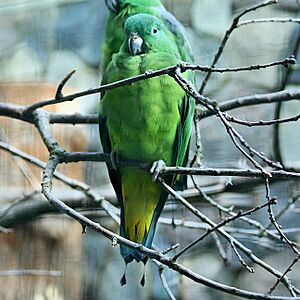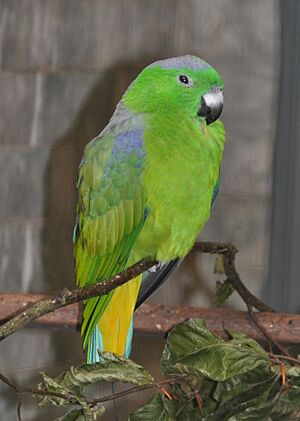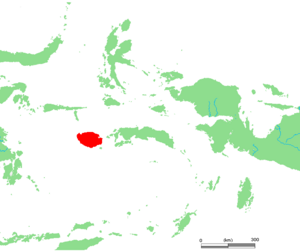Buru racket-tail facts for kids
The Buru racket-tail (scientific name: Prioniturus mada) is a special type of parrot. It belongs to the Psittaculidae family, which includes many colorful parrots. This bird lives only in the forests of Buru, an island in Indonesia. Buru is part of the beautiful Maluku Islands.
Quick facts for kids Buru racket-tail |
|
|---|---|
 |
|
| Female with male in background | |
 |
|
| Male at Walsrode Bird Park | |
| Conservation status | |
| Scientific classification | |
| Genus: |
Prioniturus
|
| Species: |
mada
|
 |
|
| The Indonesian island of Buru, its range, in red | |
Contents
What Does the Buru Racket-tail Look Like?
This amazing parrot is mostly green. It grows to be about 32 cm (13 in) long. Its beak is dark, almost black, but lighter near its face. The long feathers under its tail are bright yellow.
Differences Between Males and Females
Adult male Buru racket-tails have beautiful blue feathers. This blue color covers the back of their head, their back, and even the top of their wings. Females have just a small patch of blue on the back of their neck.
Young Buru Racket-tails
Young parrots, called juveniles, look a bit different. They do not have the special racket-shaped tail feathers yet. Young males have a little blue on their neck. Young females are completely green on their upper body.
Where Does the Buru Racket-tail Live?
The Buru racket-tail is found only on the island of Buru in Indonesia. This island is part of the Maluku Islands archipelago. You won't find this specific parrot living wild anywhere else in the world!
What Kind of Home Does It Like?
Prioniturus mada usually lives in different kinds of forests. You can find them in areas up to about 1600 meters high. They love both very old forests and taller newer forests. Sometimes, they even live in trees found near farms and small villages.
How Does the Buru Racket-tail Live?
These parrots often fly around in groups. A flock can have up to 10 birds. They are a bit like nomads, moving around with the seasons. They travel to different parts of the mountains to find trees that are full of fruit.
What Do They Eat?
The Buru racket-tail enjoys a diet of wild fruits. They also eat seeds, tasty berries, and colorful flowers.
Breeding and Babies
Female Buru racket-tails usually lay up to five eggs at a time. The time when they have their babies is known to be from December to February.
What Dangers Does It Face?
Like many other birds in Indonesia, the Buru racket-tail is facing challenges. Its home is shrinking due to habitat destruction. This happens when forests are cut down for different reasons.
Reasons for Habitat Loss
Forests are cleared to create plantations, especially for palm oil. Trees are also cut down for logging and for mining operations. All these activities reduce the amount of forest where the parrots can live.
Other Threats
These beautiful birds are also sometimes caught. They are then sold in the exotic pet trade. This also puts their numbers at risk.


